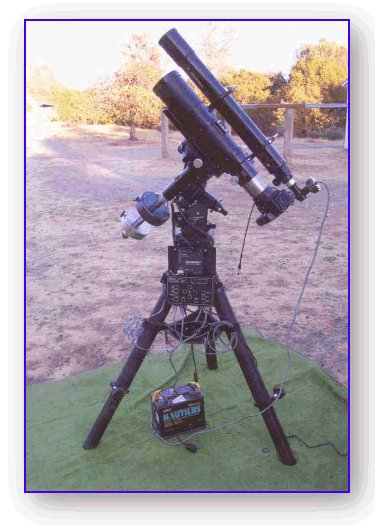| If you are only going to stop at one
site to learn about film imaging and image processing, go to: Jerry
Lodriguss'--you won't regret any time spent there... But there are
other excellent sites out there: I think of Chris Cook's and Wil Milan's...
Check my links page. For CCD imaging--techniques
and processing--there are even more excellent sites out there: Robert
Gendler, Ron Wodaski, John A. McCubbin, and Christopher Anderson come to
mind...
Nuances I've Learned (the hard way) About My
Setup
The Losmandy G11 mount / ST-4 setup is very capable,
and probably the 'best buy' in imaging setups out there (the ST-4 is no
longer made, but can be found used). What do I not like about this
setup?
The G11 can be sticky when slewing around by
hand (I'll throw my 'two cents' in about GOTO capabilities later), but it is
an easy matter to re-lube the bearing surfaces once a year--in fact, there
is a Webpage or two devoted to this... There are no fine adjustments by
hand--you must pick up the hand-controller. Though Losmandy machining is
very beautiful and tactile to the touch, their cast-iron counterweights
leave something to be desired in the 'fit and finish' department. Likewise,
their polar alignment scope--though quite accurate in my experience--has a
funky 9-volt battery dangling in the wind (in fact, a wire is broken in mine
which I now must fix!). I've heard that periodic error can be significant in
G11's--this has not been the case with mine, judging by the average
corrections of the ST-4 when I am polar aligned properly (usually '1' or '2'
over a cycle).
The ST-4: Read the directions and practice in your
backyard (if you have one--I don't) before you go to your dark sky
site! Print the 'ST-4 tips page' (which can be found on several websites,
including Chuck Vaughn's) and bring them with you. Have an experienced
partner nearby the first few times you attempt to use the ST-4! I had a
'flip mirror' device (from a now-bankrupt company <hmmm?>) that came with my
used ST-4; I no longer use it--it was NOT parfocal, and the center of the
reticle was NOT the center of the chip! My procedure now is as follows: Find
a guide star, center it in a Celestron reticle eyepiece--pushing down a
little bit to compensate for the added weight of the ST-4 head... Replace
reticle eyepiece with parfocal eyepiece (be sure I am wearing my glasses!);
focus; replace this eyepiece with the ST-4. This procedure usually works
like a charm, after I take a dark frame, of course, and proceed to the 'find
and focus' mode... But before I go to the 'calibrate drive' mode, I make
sure my "TVC" (backlash compensation) is on the third or fourth LED from the
left. Also--and equally important--I make sure the drive corrections (the
speed of the slew) on the G11 control panel is on .5x or 2x (if .5x gives an
error message in calibration mode). Occasionally--if I still have
errors (watch the readout when calibrating)-- I will have to fiddle with the
"CA" mode--this adjusts the time (independently) each axis is receiving
commands to move... This often happens if I am shooting low in the East or
South-east.
GOTO or no GOTO? I have nothing against this
technology, in fact, I have my 17.5-incher sometimes equipped with
DSC's, which ain't exactly GOTO, but very closely related. For $1500 I could
outfit my G11 with GOTO. But for me: it is not necessary or desired when
imaging. First of all, I like to star hop. And being an old
deep-sky observer turned imager, I don't get enough of it (star-hopping,
that is): While the ST-4 and G11 are ticking away for an hour or more,
I can't look through any telescopes! (Unless, that is, I cram another scope
in my little car, or there are other observers at my site--where I go,
usually this is one night in three)... So my star hopping is just like when
I "observed": get out the maps, or boot up MegaStar, look naked-eye at the
sky and try to make sense of the map/territory... When I've done that, point
the scope, look through the finder; try to make more sense out of the
map/territory thing... "Go to" the depth of perception a little further and
do the same thing through the eyepiece/telescope combination (can't do this
with the Fastar setup though). It ain't that hard or time consuming:
in fact, it is a lot of fun!
HOME
.
|
